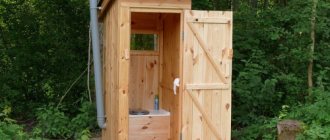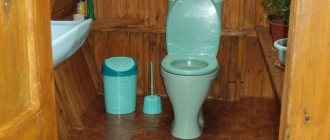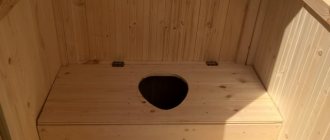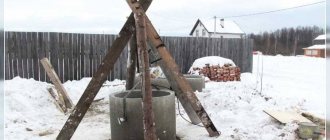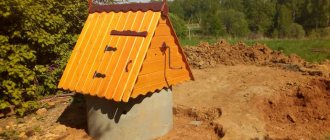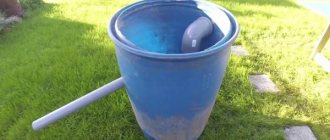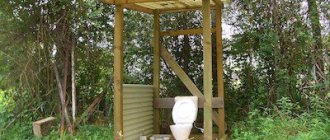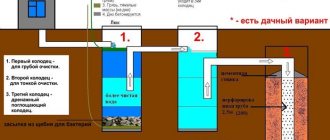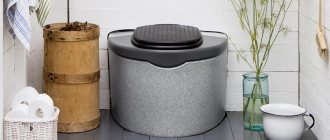Requirements for a toilet pit in the country
Before arranging a toilet, it is worth considering how often it will be used and by how many people. If the dacha is visited only in the summer, and the toilet will be used by 1-2 people, then a simple and small reservoir for draining feces will do. If the visit is intensive and regular, then you need to take care of a larger volume, tightness and the ability to clean the tank. If in the spring the groundwater at the dacha rises above 2.5 m, then it is impossible to equip a cesspool.
Important! In a country house with an extremely high level of wastewater, it is better to install a dry closet due to the likelihood of faeces being washed out.
If there is a well or a well at the dacha, then the toilet must be located definitely below the water. If the street cesspool overflows, the waste will not clog the drinking and technical source.
The bottom of the cesspool can be completely sealed or based on the filter principle using only a drainage pad made of sand and crushed stone. In the case of an insulated septic tank, faeces will need to be removed periodically using a suitable method. With a filter bottom, it is believed that the liquid part of the waste, undergoing some purification by drainage, will be absorbed into the soil. With this method, there is a high probability that the bottom of the cesspool will silt, which will prevent liquid from seeping into the soil.
Where should the structure be located?
Before building a toilet, a location for its construction is determined. The distance of the toilet from other buildings depends on its design. More precisely, whether it will be a building with or without a cesspool.
Which type of toilet to choose is decided not only by preference, but also by the location of groundwater. If they are located above the 2.5 meter mark, the construction of a cesspool is prohibited. In such cases, a powder closet is built.
When choosing a place to build, do not forget that this is a place of solitude. Therefore, it is advisable to give him a corner away from buildings.
When constructing a toilet with a cesspool, follow sanitary standards for such structures. The toilet should be located no closer than 12 meters to residential buildings. The distance from it to the water source is at least 20 meters. To avoid misunderstandings with neighbors, we are building a toilet in the country, one and a half meters away from the fence.
When planning the construction of a country toilet with a cesspool, think about how a sewer truck will subsequently approach it. The length of the sewage pumping hose is only 7 meters. Moreover, 3 of them will be located in the pit.
Also consider the landscape of the site. The cesspool of a toilet built in a low-lying area will fill quickly during the rainy season and spring snowmelt. And the building on a hill is blown from all sides by the wind.
Choosing a place for a pit for a toilet in the country
To make a cesspool toilet in the country, you need to choose the optimal location on your personal plot.
Basic sanitary standards that regulate the location of the cesspool of an outdoor toilet in a country house:
- The pit should be at least 12 m from a residential building.
- The toilet pit should be 4 m away from trees and 2 m away from bushes.
- The distance from the pit to the fence is at least 1 m.
- The pit is located more than 30 m from any source of water. The construction of a pit without a bottom near water bodies is prohibited.
- The distance to outbuildings on the site must be at least 4 m.
Such strict requirements for the placement of a cesspool in a dacha are due to the fact that waste comes into direct contact with the soil, which can lead to the spread of serious diseases.
In addition to compliance with the basic provisions of SNiP, they take into account the requirements for their own and neighboring plots.
When choosing a place to dig a hole for a toilet in the country with your own hands, take into account the direction of the wind. You need to observe in which direction the strong wind blows most often, position the tank so that the smell from the pit does not go to residential buildings and the veranda. It is imperative to provide access for the cesspool truck to the toilet if the pit is supposed to be such that special equipment is required to clean it. Due to its dimensions, the machine itself should go to the toilet, and the pumping hose could unfold freely.
How to make a slate drain pit
Wave slate is often used to strengthen the walls of a cesspool. To do this, rectangular holes are dug, the dimensions of which should correspond to the dimensions of the selected slate.
The first sheet is placed on the bottom. The next one is laid on top of the first one so that the waves of the sheets touch at the highest points. The slate is laid in this way until the topmost point of the prepared pit remains 0.3 - 0.4 m.
A drain pipe is inserted into the upper quarter of the formed structure. To strengthen the structure, broken pieces of slate are used and the empty space is filled with soil.
Attention! The choice in favor of wave slate is made when constructing a toilet on an area with sandy soil.
Instead of wave slate, you can use flat slate. The order of work in this case is slightly different.
For this:
- A hole is dug, the dimensions of which should correspond to the dimensions of the selected sheets;
- Two metal frames are being welded. For their manufacture, corners are used;
- The first is placed on the bottom;
- Pipes are welded to the corners of the lower frame. The second part of the pipe is welded to the corresponding corners of the upper frame;
- The slate is screwed to the manufactured frame. Self-tapping screws are used to secure it;
- The space between the pit wall and the slate is filled with soil and thoroughly compacted.
Width and depth of pit for a toilet in the country
As a rule, a cesspool outdoor toilet on a summer cottage is placed in a shallow hole. Its optimal depth is 1.5-2 m. The width of the cesspool for digging should be within 1.5 m by 1.5 m. For the construction of an ordinary country toilet, such a tank is quite sufficient; as the width of the side walls increases, it becomes more difficult to cover the pit.
When the pit is designed not only for toilet waste, but also for waste from a residential building, then to calculate the width and depth, the number of people living in the country is taken into account. On average, 1 person consumes 180 liters of water per day. Having made simple calculations, it becomes clear that, for example, 3 people will fill a waste pit with 12 m3 per month of constant use. The pit is made with a reserve, so its volume in this case should be at least 18 m3.
Comment! A pit without a bottom at the dacha is made taking into account the soil. Sandy and loose soil absorbs up to 40% of water, and clay soil does not absorb water well, so the pit is made with a reserve.
In any case, a hole for a latrine in a dacha should not be dug deeper than 3 m. If this depth is not enough, then it is better to install a septic tank or pump out waste more often.
DIY country toilet step by step - construction instructions
You should remember when planning to build a toilet for your dacha with your own hands - step-by-step instructions will be specific for each of the options, of which there are quite a few. Structures can work according to different principles, and materials for construction are selected taking into account their cost, durability and aesthetic appeal. Experts recommend that before purchasing materials and building a toilet, not only carefully consider the chosen option, but also make the necessary calculations, find the optimal location for installation, and draw a diagram or drawing.
How to make a pit for a toilet in the country with your own hands
After choosing a suitable location for the toilet and calculating the volume of the hole, you can begin digging a pit.
To dig a hole for a toilet in a country house of the required size and shape, you need to decide how the walls will be reinforced. A cesspool without arrangement is unsuitable for use due to the fact that the earthen walls will crumble over time. This will lead to a significant reduction in the volume of the cesspool and is fraught with deformation of the entire toilet. Also, direct contact of feces with the ground will have a detrimental effect on the quality of the soil on the site. Strengthening the walls of a cesspool in a country house can be done independently using available materials, without resorting to the help of special equipment and without expensive septic tanks.
Materials for constructing a pit for a country toilet
Several decades ago, the pit for the country toilet had earthen walls. The booth was simply placed over a dug pit and gradually filled with feces. But such a pit is not only not durable, but also dangerous. Therefore, it is necessary to build stronger and more airtight sump walls.
The following can be used as building materials:
- Brick;
- Concrete;
- Plastic.
Brickwork has a large number of unprotected places in the seams, where there may be an insufficient amount of mortar. Therefore, when using this building material to construct a pit for a country toilet, it is necessary to plaster the walls of the lined well. The shape of the pit is made round, but you can choose a rectangular or square format.
Concrete makes a more airtight garden pit. This material is perfect for creating wells with a bottom. In this case, a solid structure is obtained that has good durability. But such a pit can be strengthened only with the help of steel or fiberglass reinforcement.
Plastic containers can provide maximum tightness to the pit. The only limitation for the use of these structures may be the presence of stiffeners. In their absence, the tank will deform due to constant soil displacement.
How to strengthen a toilet pit in a country house
You can secure the dug pit for the toilet with any material that is not subject to decomposition in sewage. Depending on the chosen resource, strengthening can be absolutely free or quite affordable for the owner of a summer cottage.
Tire pit
Old unnecessary tires are one of the cheap and functional options for arranging a cesspool toilet when 1-2 people live at the dacha during the warm period. This design is easy to install and can be done in one day. Any tires are suitable for arranging a pit; the wider their diameter, the larger the volume of the cesspool.
Installation of a cesspool for a latrine made of tires is simple. You need to find about 8-10 medium-sized tires. The easiest way is to search the service station for used tires that are no longer useful for cars. A hole is dug along the outline of one tire, adding 20 cm to the diameter.
Then a drainage layer is made at the bottom of the pit - 5 cm of sand and 20 cm of crushed stone are poured. The side rims of tires are cut off so that they do not steal volume and do not interfere with cleaning the pit. A hole is cut out on the rim of one wheel for the exhaust pipe. Place the tires on top of each other on the drainage pad of the pit, completing the pyramid with a wheel with a hole for the pipe. Insert the pipe into the hole.
The gap between the pit soil and the tires is filled with small stones and sand or crushed stone.
Cover the pit with a wheeled structure with a metal lid at least 4-5 mm thick or a strong wooden shield with a hole for the hatch.
Important! Such a cesspool for an outdoor toilet in a country house made from tires will last no more than 15-20 years.
Brick pit
The side walls of the brick cesspool can be any within one and a half meters. The optimal depth of a brick tank is 2 m. These parameters are selected depending on the number of people who will use the toilet in the country. The more people there are, the wider and deeper the hole is made.
The operating principle is as follows:
- It is necessary to dig a rectangular hole for a toilet in the country according to the selected dimensions. The bottom of the pit is compacted, 10-15 cm of sand and gravel are poured and a concrete screed is formed with the addition of crushed stone. The pit is left until it hardens completely.
- Lay out the brick walls in a dressing, finishing the laying 10-15 cm above the ground surface.
- Brick walls are plastered and treated with bitumen mastic for additional sealing of the pit. Fill the gap between the walls of the pit and the brickwork with soil and compact it tightly. The entire structure is covered with a metal plate or thick boards, leaving a hole for the toilet.
Important! To lay out a cesspool tank in a country house, red brick is chosen because of its resistance to moisture.
Concrete rings
A cesspool for a toilet in a country house is equipped with concrete rings using lifting equipment, but the process itself is quick, like assembling a construction set.
- Dig a hole the size of a concrete ring with a margin of 15-20 cm. Drain the bottom with sand and crushed stone to a depth of 20-25 cm. Fill the bottom of the hole with concrete or place a ring with a cast bottom first. When filling the bottom with cement mortar, leave the cesspool to dry completely.
- Using a crane, the rings are lowered into the pit, pre-lubricating the joints with cement mortar if there are no locking locks. The rings are tightened together with a bandage of bolts and steel plates to prevent them from shifting.
- Treat the concrete surface with bitumen for additional insulation. Fill the gaps between the rings and the walls of the cesspool with soil. Cover the structure with a concrete slab or thick metal sheets with a hole for the hatch.
There is one clever way to install concrete rings without using a crane. The first ring is installed by rolling on the place where the toilet will be in the country. Using a bucket and shovel, remove the soil inside the ring. The heavy concrete ring sags under its own weight as the earth is excavated. When the top of the ring sinks to the same level as the surface, roll on the second ring. This continues until all the rings are installed in the cesspool.
Attention! With this method, you cannot use a ring with a cast bottom first. This will make the principle of installing a concrete pit tank without the use of a crane impossible.
Plastic tank
One of the easiest, but not the most budget-friendly options for constructing a cesspool in a country house for a toilet is to bury a thick plastic container to accumulate feces. For this purpose, Eurocubes or large plastic barrels are used.
This creates a sealed latrine tank. After purchasing a plastic tank, they begin to install the structure.
- Dig a hole in a summer cottage slightly larger than the container. A 15-20 cm gap between the earthen walls and the tank is sufficient. The pit is drained with pebbles and sand to a depth of 10-15 cm. A reinforcing mesh with metal loops is formed. Fill the structure with cement mortar so that the rings protrude in height from the concrete. Let it dry.
- Having tied a plastic container with cables, they lower it into the cesspool. Cables are attached to the protruding loops so that the fixation does not allow groundwater to push the lightweight plastic tank upward in the future. Fill the fixed tank with water to prevent it from being crushed when backfilling.
- Fill the gap between the walls of the earth and the PVC tank. To do this, it is better to take a dry mixture consisting of 5 parts of coarse sand and one component of cement. Compact thoroughly. Pump water out of the reservoir. Cover with the lid provided with the container. A concrete platform is poured over a plastic cesspool.
Comment! The more people use the toilet in the country, the larger the volume of the plastic cesspool should be.
Monolithic pit
The construction of a reinforced monolithic cesspool for an outdoor toilet is an expensive and labor-intensive construction. But there are cases when you can’t do without it, for example, if you plan to combine the drainage of waste water from a toilet, bathhouse and home.
In this case, dig a hole of the required size. A drainage cushion of sand and gravel 20-25 cm is poured. A steel reinforced mesh is placed on the drainage. From its outer edges, reinforcement is placed along the walls of the cesspool. Fill the bottom with cement mortar. Let it dry. Formwork is erected around the perimeter of the pit. The roofing felt sheets are fixed, which will serve as a flat formwork wall. Concrete is poured in layers, periodically piercing with a stick to compact the mixture. Pouring the mortar into the walls of the cesspool must be done within one day. When the structure is completely filled, the pit is left until it dries thoroughly. The formwork is removed and checked for possible voids and defects in the concrete walls. If necessary, level until complete sealing is achieved.
Cover the cement cesspool with concrete slabs or a metal shield with a hole.
Construction of a cesspool
Cesspools can be sealed or not sealed, i.e. having no bottom. The last option is a tank, the walls of which protect the soil layers from the penetration of runoff. The bottom of the structure involves the use of a filter made of gravel and crushed stone. The advantage of the system is that there is no need for pumping with sewage disposal equipment - a suction pump.
It is not recommended to install a toilet for a summer residence without a solid bottom if groundwater is close to it. This will affect the filling of the tank during rain and will have a negative impact on the quality of filtration. Contaminated streams do not undergo purification, but immediately go into groundwater.
A hermetically sealed country toilet is a storage device. Waste is removed using pumping equipment. This option eliminates the release of bacteria and soil contamination.
The toilet in the country is made from the following materials:
- Tire structures are made without a special bottom. They are characterized by quick installation and low price.
- Concrete rings are a durable and reliable material. Lifting equipment is required to install them in the pit.
- You can quickly install a toilet from a barrel. It is suitable as a storage device. To install the filter you will need to remove the bottom.
Plastic models require additional fixation to the foundation. This will prevent it from floating during rainy periods. During backfilling, the tank must be filled with water to prevent deformation.
The design can be rectangular or round. The configuration should be selected taking into account the shape of the site. Concrete devices are made using formwork. Brickwork is done in a circle. When applying the methods, it is necessary to use a layer of waterproofing.
Digging a pit
The cesspool must have a depth of at least two meters. But the groundwater level must be below this mark. It is important to choose the right place to place the pit.
It should not be located on a slope of the site or away from the road. The hole is dug using an excavator or manually. Its width should be 50 centimeters wider than the intended container. This distance should be left for cladding. Additionally, you need to make trenches for the pipes.
Arrangement of the bottom of the sump
For a country toilet with a storage pit, a bottom filter is required. It is made from gravel and sand. You can also take crushed stone of certain fractions. A layer of sand is poured onto the bottom, and layers of gravel and crushed stone are placed on top.
Small elements should be located at the bottom, and large ones at the top. A concrete slab is laid on top of the embankment or a screed is made.
Arrangement of the internal part of the storage pit
To create an odorless toilet for your dacha with your own hands, you need not only to dig a pit, but also to finish the walls.
The following materials can be used for surface finishing:
- Concrete. The concrete solution is poured into pre-made formwork. The thickness of the layer should be at least 7 cm.
- Brick. Using red brick, the walls are laid out from the bottom to the very top.
- Rings. Laying reinforced concrete rings requires special equipment. The rings are laid out on a concrete base. The joints are treated with cement mortar.
After finishing the walls, the pit is connected to the sewer pipes. To create a tight seal, special rubber connectors are used. The outside of the pit is finished with clay or roofing felt.
The pit is covered with wooden logs and slate or a concrete slab. There must be a hole in the ceiling.
Making a wooden cabin
A wooden booth can be made from different materials - boards, profile sheets or bricks.
When arranging a cabin, ventilation and reliability are important parameters. The plank bathroom is especially popular. Wooden frames can be easily rearranged to a convenient location. When choosing wood as a material, it is worth considering that it can easily crack when exposed to sunlight or become deformed from humidity.
Wood requires special processing and varnishing. After installing the walls and floor, you must perform the following steps:
- Door installation. Additionally, you can make a slot in the form of a window.
- Roof installation. A profile sheet, roofing felt or asbestos cement sheet is suitable for finishing the roof.
- Applying the finishing coat. You can use paint or varnish.
The metal version is also popular. The metal or wooden frame is upholstered with profile sheets and secured with screws. We invite you to read the step-by-step instructions on how to build a wooden toilet stall with your own hands.
An important point is ventilation. This system is designed to remove unpleasant odors from the country toilet. A pipe is used to provide ventilation.
Installation of the cabin on the pit
Advice! It is important to choose a suitable foundation. A practical solution would be a tape-type base.
To build it, a minimum of excavation work and a small amount of cement are required. Moreover, such a foundation ensures stability on any type of foundation. For light houses, a foundation on pillars is suitable.
The concrete curb is installed at a distance of no more than 0.2 meters from the edge of the pit. Roofing material is laid on top of the base in several layers. The floor is made of thick boards, the thickness of which is at least 4 cm.
Find out how to choose a toilet for a country toilet - what models there are, how to install them or how to make a toilet seat yourself.
How to clean a toilet pit in a country house
A toilet cesspool made from any materials needs cleaning over time. There are different methods of cleansing:
- A pit at a summer cottage is cleaned on your own using scoops, pumps and other manual means. This option is absolutely free, but causes a lot of inconvenience due to the spread of a pungent odor and the disposal of feces.
- Calling a sewer truck. This is the most environmentally friendly and simplest method of cleaning a toilet pit in a country house, but it is only possible if there is good access from a machine with a hose.
- The use of biological products that decompose waste directly in the cesspool. The use of such means for processing feces at the dacha will allow the use of decomposition products as fertilizers on the site.
- If there is a need to clean the cesspool of a toilet in the country in the winter, then biological products will not cope. At sub-zero temperatures, bacteria do not multiply and the drug will not work. Then chemicals are used, after which the remaining waste is disposed of.
How to make a cesspool for an outdoor toilet from a plastic barrel
After a certain period of use, the metal container begins to corrode and gradually collapses. This negative phenomenon can be prevented by replacing a metal tank with a plastic one. Such products have less weight, which greatly simplifies installation work and transportation.
Installation work includes:
- Digging a hole whose dimensions are slightly larger than the dimensions of the selected plastic container. The gap between the walls of the barrel and the ground should be about 15 - 20 cm. This is enough for the product to be lowered into the hole without hindrance;
- Bottom drainage using sand and pebbles. The thickness of the formed layer should be 10 – 15 cm;
- Reinforcement of the bottom using a mesh and subsequent pouring of cement mortar. Special metal loops are placed in the concrete and fixed;
- Lowering a plastic container into a cesspool. Attaching the container to metal loops at the bottom to prevent it from being pushed out by groundwater;
- Filling the space between the walls of the container and the ground with a mixture consisting of five parts sand and one part cement with its obligatory compaction.
Which toilet to choose for a garden garden dry powder closet
A dry toilet (powder closet) is a small structure containing a regular wooden toilet seat with a lid, and underneath it there is an easily removable container. Next to the toilet seat, place a container with peat, sawdust or other dry material for sprinkling (powdering) sewage after each visit to the toilet. For such dusting of waste, you can also use ash, dry peat or peat chips. If there is a lack of these components in this type of garden toilet, it is allowed to use a mixture of these materials with dry garden soil. Because of this powdering process, the name of this type of toilet appeared.
With the help of powder you can get rid of an unpleasant odor, prevent the breeding of flies and obtain a complete fertilizer.
A properly equipped dry toilet, when used correctly, will be the most suitable low-cost option. The principle of operation of the sewage system of such a toilet is the action of gravity in the presence of a natural slope.
Every 3-4 days, the filled container must be carefully removed through the rear side door and emptied into a compost pit or into a special tank, where the contents should be covered with peat or sawdust.
If the toilet is used by 4-5 people or more, it is recommended to empty the container more often. It is advisable to remove the contents daily to make lifting the container easier. Subsequently, compost can be obtained from it, suitable for fertilizing the garden.
When deciding which toilet to build in your dacha, keep in mind that building a powder closet along with the cost of a galvanized or enameled bucket is considered the cheapest option. In addition, there is another advantage of this type of toilet: no approvals are required for its construction
An important feature of the powder closet is the absence of a cesspool, therefore only this type of toilet is allowed to be built even with a high groundwater level
A powder closet at the dacha is an ideal dacha option, especially if a large number of plants are grown on the site for which fertilizers are expected to be used, because the contents of the storage tank of such a toilet can easily be transferred to the compost heap.
A dry toilet for a summer residence can be located anywhere on the site; it is allowed to be combined with a bathhouse or other outbuildings. In addition, it can be located near a residential building or in an extension under the same roof with it, provided there is adequate ventilation.
A country dry toilet is very convenient if there is no water supply network on the site. When using peat or peat crumbs to powder waste, you get something like a homemade peat biological toilet, which has its own significant advantages over a toilet with a traditional pit cesspool.
At the same time, you do not need to spend extra money on purchasing a plastic peat dry closet.
It is necessary to have a compost pit at your summer cottage, since almost all biological toilets found on sale require access to a sewerage system or to a compost pit.
Distance to pit toilet for 2021
For holiday villages, sanitary standards were adjusted taking into account the constant complaints and disputes of neighbors about the discomfort from neighboring toilets. According to SNiP 30-02-97 as amended in 2021 and SP 53.13330.2011, in the territory of dacha settlements, rural and urban settlements, toilets with cesspool type pits should be installed at a distance of 12 m instead of 8–10 m.
Their construction for a holiday village requires permission from the SES at the design stage. Instead of traditional houses over a pit, it is recommended to build septic tanks and install biotoilets with special compounds processing feces into odorless inorganic substances, as well as powder toilets with processing feces into dry matter. There are standards for the installation of powder closets with the collection of waste into boxes with powder, drying of the contents and processing into inorganic fertilizer.
Scheme of distances from the fence at SNT and individual housing construction sites
If you have a home sewer system and the types of pits recommended by SNiP, you can place the toilet closer. The demarcation between a dry closet and a septic tank from a neighbor's house is allowed 6 m, for a powder closet - 8 m.
The distance from the toilet to the neighbor’s residential building should be measured at 12 m, the same as to your own. According to changes in SNiP, the permissible distance to the playground and cellar remains 8 meters.
Layout of buildings according to norms and rules
Based on SanPiN 42-128-4690-88, for places where the size of the plots does not allow maintaining the distance to yard toilets and waste disposal pits, standards are established by a commission that includes representatives:
- Quarterly Committee.
- Regional architecture.
- SES - Sanitary and Epidemiological Station.
- Housing and maintenance department.
Based on the results of the site inspection, the commission draws up a report with recommendations on the layout of plots and changes in the minimum distances between residential buildings and toilets. Documents are submitted to the executive committee or village council for approval.
Chalet
In rural areas or villages, in cities and towns, an outdoor public toilet should be located from public buildings, schools and shops at a distance of 20 to 100 m.
Requirements for a dry country peat toilet
It is recommended to use peat for a country peat toilet, because the bacteria contained in it contribute to the active decomposition of natural human biological waste. In just a few weeks they turn them into quality garden fertilizer
It is important to cover the waste with a layer of peat after each visit to such a toilet, this will ensure better composting. For a dry toilet in the country, only dry peat is needed
It should be poured into a container next to the toilet seat, and also be sure to be placed at the bottom of a clean bucket to make it easier to clean the container later. If necessary, you can use a tank from half a barrel instead of a bucket, so the volume can be increased to 100 liters. A homemade peat biological toilet can be built in cases where there are no necessary conditions for constructing a cesspool, installing a septic tank, or supplying water to the toilet.
If sawdust is used instead of peat in a dry garden toilet, then the desired effect of rapid waste composting is unlikely to be achieved. It is recommended to use sawdust in half mixed with peat if there is a large receiving container (50-100 l). When using sawdust, the aeration of the substrate improves. Food waste, plant debris, tops, leaves, weeds and other household waste often end up in a compost pit. When their layer reaches 20-30 cm, it must be sprinkled with peat, sand or dry garden soil, and then it can be watered generously with fecal slurry. It should be noted that adding faeces to the compost mixture along with dry garden waste, leaves and other organic matter for hygienic reasons is only possible if the composting process is carefully controlled.
In no case should flies be allowed to spread, so the pile should be covered with film, firmly secured to the sides of the pit so that the wind does not blow it away.
The only disadvantage of a dry toilet is the regular transfer of a storage container to the compost pit after each filling. Large bins filled with waste are quite heavy. To make emptying the container easier, we recommend using a standard wheelie bin.
For a simple do-it-yourself biological litter box, you can use a large bucket, a garbage bag, and cat litter. To do this, you need to make a wooden toilet seat to fit a large bucket, then put a large garbage bag in it and attach it to the toilet seat using plumbing tape.
As you use the toilet, you need to pour cat litter into the bag. Once filled, the bag should be looped halfway and removed. Then it can be placed in the far corner to rot or immediately emptied into a compost pit. You need to put a new bag in its place. The procedure for changing the bag should be carried out with gloves.
Cost of work
The question of how much it costs to build a toilet in a country house with a cesspool is no less relevant today than it was several years ago. An economical option for a summer house, which is used only in the warm season, the optimal solution.
Today, many companies present a service - installing a turnkey toilet in a country house. They offer several options, in which they mainly use plastic containers as a cesspool. The price varies depending on the volume of the barrel, the size of the toilet itself, the finishing and other things. For example, a wooden house measuring 1x1.2x2.2 m and a barrel with a volume of 1 m³ costs 25,000 rubles.
